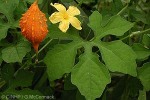Cook Islands Biodiversity Database
Species Page
Momordica charantia
Pōkutekute Rengarenga* (AT)Balsam Pear
Multimedia & Additional Resources
| Type | Description | Download |
| Leaves, flowers and fruit | 57KB |
General Information
Cook Islands Distribution
| Southern Group: Present Makatea: Present | ||||||||
RR |
MG |
AT |
MK |
MT |
AK |
PL |
TK |
MN |
++++ |
++++ |
++++ |
- |
- |
+++ |
- |
- |
|
| Northern Group: - | |||||
TN |
MH |
RK |
PK |
NS |
SW |
- |
- |
- |
- |
- |
- |
Scientific Taxonomy
Momordica charantia Linnaeus
SYNONYMS: Momordica balsamina [sensu GW]; Momordica charantia var. abbreviata [wild form]
TAXONOMY: PLANTAE; ANTHOPHYTA (=Angiospermae); MAGNOLIOPSIDA (=Dicotyledones); DILLENIIDAE; Violales; CUCURBITACEAE
More Information
SIGNIFICANCE NOTES -
POSITIVE SIGNIFICANCE: Seed Food. Comments: Aitutaki: seeds eaten children.
NEGATIVE SIGNIFICANCE: Weed - moderate. Comments: A widespread low-climbing vine in fallow and waste areas.
GENERAL NOTE: A.C.Smith (Flora Vitiensis Nova, 1981) "probably indigenous in southern Pacific, having been obtained in Tahiti by the first Cook expedition. It could, of course, have been an aboriginal introduction, but this is not suggested by it usually coastal habitat."
Elsewhere there are edible varieties of this species known as Bitter Melons or Foo Gwa. For example, a variety known as Short Bitter-Melon is commonly found in markets in Fiji.
Vouchers & References
Vouchers:
None Recorded.
References:
p.572 Wagner et al.- Flowering Plants of Hawaii
p.808 Neal - In Gardens of Hawaii
p.737 Hortus 3rd
p.753 Royal Hort. Soc. Index of Garden Plants
p.383 Tropica
p.2/675 A.C.Smith - Flora Vitiensis Nova
p.103 Wilder - Flora of Rarotonga
p.392e Whistler - Ethnobotany of the Cook Islands
p.84 McCormack/Kunzle - Rarotonga's Mountain Tracks and Plants
Data Update History (information):
zTX, zB02, zM02, zupM03a, mD05b
Web Resources
Citation Information
McCormack, Gerald (2007) Cook Islands Biodiversity Database, Version 2007.2. Cook Islands Natural Heritage Trust, Rarotonga. Online at http://cookislands.bishopmuseum.org. ![]()
Please refer to our use policy.

